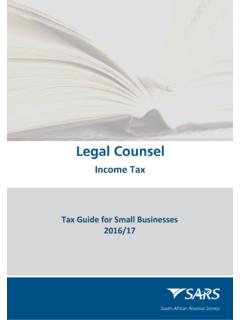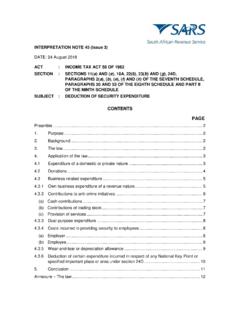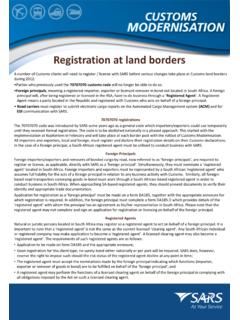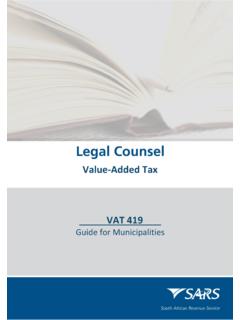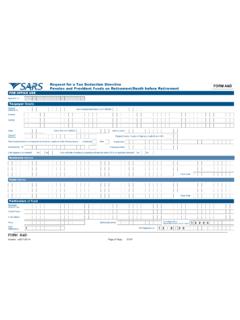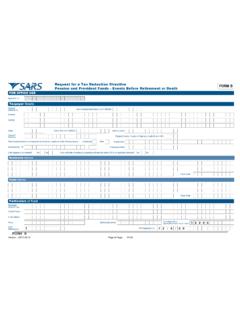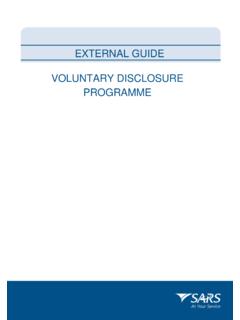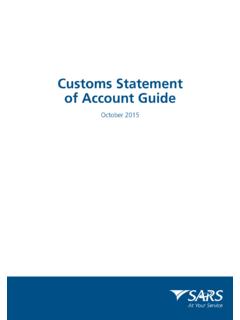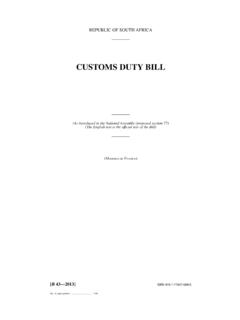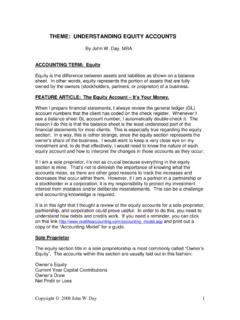Transcription of INTERPRETATION NOTE: NO. 14 (Issue 3) ACT : …
1 INTERPRETATION NOTE: NO. 14 ( issue 3) DATE: 20 March 2013 ACT : INCOME TAX ACT NO. 58 OF 1962 (the Act) SECTION : SECTIONS 8(1)(a); 8(1)(b) and 8(1)(c) AND PARAGRAPH 1 OF THE FOURTH SCHEDULE SUBJECT : ALLOWANCES, ADVANCES AND REIMBURSEMENTS CONTENTS PAGE Preamble .. 2 1. Purpose .. 2 2. Background .. 2 3. The nature of allowances, advances and reimbursements .. 3 Definition of the terms allowance , advance and reimbursement for the purposes of section 8(1) .. 3 Allowance .. 3 Advance .. 3 Reimbursement .. 4 General observations on the nature of allowances, advances and reimbursements .. 4 4. The law .. 5 5. Application of the law .. 5 Inclusion in taxable income allowances and advances .. 5 The terms principal and recipient .. 5 Exclusion from taxable income reimbursements and advances.
2 6 Deductions from subsistence allowances .. 6 General .. 6 Actual method .. 7 Deemed method .. 8 Examples .. 9 Deductions from travelling allowances and advances .. 12 General .. 12 Kilometres .. 13 Expenditure per kilometre actual costs .. 14 Expenditure per kilometre deemed rate per kilometre .. 16 2 Deduction under section 11(a) .. 19 6. Employees tax .. 20 General .. 20 Subsistence allowances .. 20 Travel allowance and reimbursive travel claims .. 20 Travel allowance .. 20 Reimbursive travel 22 7. Conclusion .. 22 Annexure A The law .. 23 Annexure B Table of rate per kilometre .. 26 Preamble In this Note, unless the context indicates otherwise section means a section of the Act; and any word or expression bears the meaning ascribed to it in the Act. 1. Purpose This Note provides clarity on the tax treatment of allowances, advances and reimbursements granted to employees and office holders and gives guidance on the record-keeping requirements relating to motor vehicles.
3 The Note updates and replaces issue 2 which was published on 8 January 2008 and incorporates relevant legislation changes up to and including the Taxation Laws Amendment Act No. 22 of 2012. 2. Background In line with the 2002 Budget Review proposal to simplify the system of employment income taxation, the provisions relating to allowances, advances and reimbursements were previously consolidated in section 8(1). Section 23(m) was also previously enacted to limit the deductions available to employees and office holders. Since issue 2 of this Note, substantial amendments have been made to the travel allowance system. These include the removal of the deemed kilometre method of calculating the allowable deduction as well as amendments to the employees tax withholding requirements on allowances and advances.
4 The update to this Note includes these amendments and clarifies what constitutes business travel and private travel. 3 3. The nature of allowances, advances and reimbursements Definition of the terms allowance , advance and reimbursement for the purposes of section 8(1) The distinction between an allowance, an advance and a reimbursement for purposes of sections 8(1)(a), (b) and (c) is set out in Allowance An allowance is an amount of money granted by an employer to an employee to incur business -related expenditure on behalf of the employer, without an obligation on the employee to prove or account for the business -related expenditure to the employer. The amount of the allowance is based on the anticipated business -related expenditure. Example 1 Allowance Facts: ABC Ltd requires X to travel for business purposes three or four times a month.
5 ABC Ltd anticipates that X will incur R1 000 per month on business -related expenditure whilst travelling and pays an amount of R1 000 per month to cover the expenditure. X is not required to prove or account for actual business -related expenditure to ABC Ltd. Result: X receives an allowance of R1 000 per month for purposes of section 8(1). Advance An advance is an amount of money granted by an employer to an employee to incur business -related expenses on behalf of the employer, with an obligation on the employee to prove or account for the business -related expenditure to the employer. The amount of the advance is based on the anticipated business -related expenditure. The employer recovers the difference from the employee if the actual expenses incurred are less than the advance granted and vice versa.
6 Example 2 Advance Facts: A works for ABC Ltd. The company has asked A to visit a key client to conduct a client satisfaction survey and, after completing the survey, to entertain the client by way of a business lunch. A is paid an amount of R500 by ABC Ltd to cover the cost of the lunch. A must submit receipts and invoices to the company accountant when returning to the office and must return any portion of the advance not spent as instructed. ABC Ltd does not think the lunch will cost more than R500, however if the client orders indulgently ABC Ltd will make good any shortfall. A is able to provide a receipt and an invoice totalling R400 and returns the remaining R100 to the company. Result: A receives an advance of R500 for purposes of section 8(1). 4 Reimbursement A reimbursement of business -related expenditure occurs when an employee has incurred and paid for business -related expenses on behalf of an employer without having had the benefit of an allowance or an advance, and is subsequently reimbursed for the exact expenditure by the employer after having proved and accounted for the expenditure to the employer.
7 Example 3 Reimbursement Facts: A (who works in East London) is required to conduct a two day training session at the company s Grahamstown branch. On arrival A discovers that the Grahamstown branch does not have all of the equipment required in order to adequately deliver the training. A s manager asked A to purchase the required items out of A s own pocket and to submit a claim on returning to East London. A spent R200 on the items and retained the receipts which prove R200 was spent on business -related expenditure. The employer subsequently reimburses A the full R200. Result: A receives a reimbursement for purposes of section 8(1). General observations on the nature of allowances, advances and reimbursements The nature of allowances, advances and reimbursements is frequently misunderstood, as are the reasons for granting recipients such amounts.
8 In this regard: Any allowance, advance or reimbursement is a reflection of business -related expenditure or anticipated business -related expenditure of the employer. A payment to an employee under the disguise of an allowance but actually for services rendered or to be rendered is subject to tax under the normal provisions of gross income and is not treated as an allowance under the provisions of section 8(1)(a). The label of a payment does not necessarily correctly reflect the true nature of the payment. The judgment in ITC 15231 confirmed that when the word allowance is used in an employee-employer relationship, it means a grant of something additional to ordinary wages. The taxpayer had received a salary and sought to claim a deemed subsistence expenditure deduction against his salary.
9 The court held that he had not received an allowance as he had not received anything extra and was not automatically entitled to the deduction provided for in section 8(1). A typical misconception is that the quantum of an allowance or advance does not have to reflect the anticipated business expense. This misconception is sometimes caused by the incorrect understanding that an allowance can, without reference to the actual expenditure anticipated, be based on the amounts of expenditure which are deemed to have been incurred by the Act under specified circumstances and that the employee will automatically be entitled to a tax deduction against that allowance . The misconception means 1 54 SATC 194. 5 that employees sometimes receive allowances that are much greater than the true anticipated business expense.
10 4. The law For ease of reference, the relevant sections of the Act are quoted in Annexure A. 5. Application of the law Inclusion in taxable income allowances and advances Section 8(1)(a)(i) deals with all allowances and advances paid by a principal to a recipient (for example, travel, subsistence, public office, cell phone and housing allowances); and provides that all such allowances and advances must be included in the recipient s taxable income to the extent that they are not expended2 for travelling on business ;3 or for accommodation, meals and incidental costs while such office holder or employee is obliged to spend at least one night away from his or her usual place of residence as a result of business or official purposes;4 or by reason of the duties attendant upon public office.
